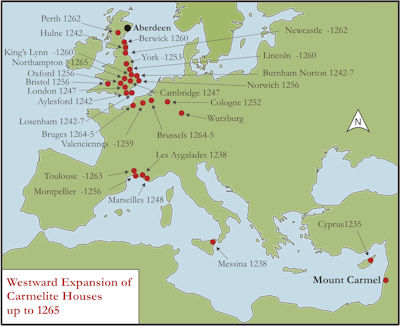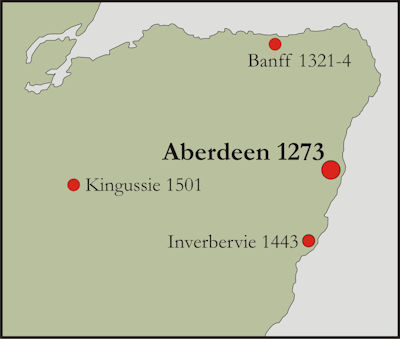

The Carmelite Friars had their origin as hermits (Friedman 1979), taking their name from the prominent mountain ridge of Mount Carmel in medieval Palestine (now Israel), where they gathered near to two very productive springs (Figure 2). Human beings had been active and indeed resident in that area for some 200,000 years before the small community, which came to be known as the 'Brothers of Our Lady of Mount Carmel', gathered together in the early 13th century in the Wadi es-Siah. These first Carmelites were in all probability of European origin, having made their way to the Holy Land in the context of the movement of people caused by the Crusades, although it has been suggested that the group which applied to Albert of Vercelli, Patriarch of Jerusalem, for a Formula vitae (Way of Life) also included some Orthodox hermits (Jotischky 2002, 12). Several writers refer to the sides of the Wadi being riddled with caves of anchorites or hermits – some of which are still visible today, despite continued erosion of the soft limestone. There were several attractions to life there, not least among them being a ready supply of water from at least two springs, both of which are still visible today. The Formula vitae, given to the developing community by Albert at some point during the years 1205-14, refers to 'the hermits…who live near the spring on Mount Carmel' (Stern forthcoming). The association of the mountain with the prophet Elijah may also have been of interest to those who sought to imitate his ascetic lifestyle.
The early Carmelites had a stone church, probably built in the early 13th century and enlarged towards the end of that same century. That second campaign may coincide with the construction of much larger buildings, related in style and monumentality both to contemporary Crusader structures in Palestine and monastic buildings in Europe. In 1263 an appeal was made for support to the Carmelites who were in the process of erecting 'opere sumpuoso' (Stern forthcoming). Remains of all these 13th century edifices can still be visited in the Wadi.
From the later 1230s and 1240s, partly owing to the uncertainties and dangers of living under Muslim pressure, a number of Carmelite brethren began to leave the Holy Land and set up houses first in Cyprus and then in Europe. In 1247 they were granted a letter by Pope Innocent IV sanctioning the establishment of daughter houses. The new 'rule' also instructed the brothers to eat in a common refectory instead of singly as before. They were thus several steps along the way towards becoming friars rather than hermits (Stern forthcoming).
A group seems to have settled on Cyprus around 1235, another appears in Messina in 1238, while a further settlement is recorded at Les Aygalades near Marseilles (Copsey 2005, vi). In 1242 the Carmelites reached England, establishing themselves at Hulne in Northumberland and Aylesford in Kent. They came in the retinue of knights returning from the Crusades, Richard de Grey at Aylesford and William de Vescy at Hulne. Substantial traces remain of the friary buildings at Hulne, while at Aylesford, which was re-established on the original site in 1949, some structures also survive from the medieval friary complex. Even today, Hulne is a secluded location, perhaps reflecting the Carmelites' continuing desire, at that stage in their Order's development, to settle in a remote place as they had done on Mount Carmel.
The years following their arrival in England marked a period of rapid expansion for the Carmelites in Europe (Figure 2) (Fitzgerald-Lombard 1992a; 1992b). London and Cambridge were founded in 1247, Marseilles in 1248, Cologne in 1252, York before 1253, Montpellier before 1256, Norwich, Oxford and Bristol in 1256, Valenciennes before 1259, King's Lynn, Lincoln and Würzburg before 1260, Toulouse before 1263, Brussels and Bruges in 1264-5. By 1274 England had 22 houses, France about the same number, Catalonia had eleven, Scotland had three and there were also houses in Italy, Germany and elsewhere (Jotischky 2002, 14). The first appearance of the Carmelites in Scotland (Figure 1) may have been at Berwick, around 1260 (Copsey 2005, 114). Shortly afterwards, in 1262, the Carmelites were offered the chance of a second foundation by the bishop of Dunkeld, at Tullilum, just outside the flourishing burgh of Perth. The Aberdeen house was established around 1273. A further eight houses were founded in Scotland (Figure 3), at Luffness, Irvine, Queensferry, Banff, Linlithgow, Inverbervie, Kingussie, with the last being at Edinburgh in the years 1520-25 (Copsey 2005, 152). By 1300 there were some 159 houses in 10 countries – the Holy Land, Cyprus, Italy, England, France, Germany, the Low Countries, Spain, Scotland and Ireland (Copsey 2005, viii).

The evolution of the Carmelites from their initial eremitical life on Mount Carmel to a mendicant order took place over perhaps three quarters of a century, culminating in the granting of a bull by Pope John XXII in 1326 which allowed the Carmelites all the same privileges as the Franciscans and Dominicans (Copsey 2005, viii). The copy of that bull which was sent to the Aberdeen house survives in the collections of the University of Aberdeen. Along the way the Carmelites had changed their name (from the 'hermits of Mount Carmel' to the 'brothers of the blessed Mary of Mount Carmel') as well as their dress (from a striped cloak to a white cloak, thus earning themselves the descriptive title of 'whitefriars'). They had also set about making themselves indispensable to the Church in various ways, establishing a study house at Paris to enable them to provide theologians and candidates for high ecclesiastical office. In addition there began to arise a new history of the Order, suggesting, among other things, that the Carmelites lay in direct eremitical descent from the times of Elijah and John the Baptist, thus attempting to create an historical identity which had previously been lacking (Copsey 2005, viii-ix).
Internet Archaeology is an open access journal based in the Department of Archaeology, University of York. Except where otherwise noted, content from this work may be used under the terms of the Creative Commons Attribution 3.0 (CC BY) Unported licence, which permits unrestricted use, distribution, and reproduction in any medium, provided that attribution to the author(s), the title of the work, the Internet Archaeology journal and the relevant URL/DOI are given.
Terms and Conditions | Legal Statements | Privacy Policy | Cookies Policy | Citing Internet Archaeology
Internet Archaeology content is preserved for the long term with the Archaeology Data Service. Help sustain and support open access publication by donating to our Open Access Archaeology Fund.